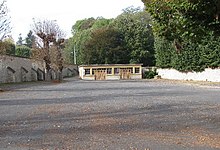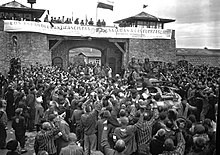Jacques de Jésus
Père Jacques de Jésus (born January 29, 1900 in Barentin as Lucien Bunel , † June 2, 1945 in Linz ) was a French priest of the Carmelite Order who deported to the Gusen concentration camp for hiding Jewish children from the Nazi occupation forces in France has been.
biography
Père Jacques de Jésus - Père Jacques for short - was born as the fourth of eight children to the married couple Alfred Joseph Bunel (1871–1943) and Zoé Pauline Pontif (1868–1952). From an early age he was fascinated by the priesthood and prophesied: “I will become a great priest”, which initially met with rejection from his parents.
With a persistent will to become a priest, he entered the "Petit séminaire de Rouen " in October 1912 . After graduating from high school in 1919, he moved to the "Grand seminaire de Rouen". In 1920 he did his military service in Montlignon . Already at that time he was fascinated by life in silence and solitude and considered entering the Cistercian abbey of La Trappe .
When he returned to Rouen, he was accepted into the seminary there on February 23, 1922 . In December 1924 Lucien Bunel received the diaconate and 1925 by the Archbishop of Rouen , André du Bois de La Villerabel , the ordination .
From 1925 to 1931, Lucien Bunel worked as a diocesan priest, among other things as an educator, teacher for English and religion and as a pastor. On August 28, 1931, he left the Diocese of Rouen and joined the Carmelites as a postulant . There he chose the religious name Jacques de Jésus to dress . His canonical novitiate year took place in Lille from September 14, 1931 to September 15, 1932 .
In March 1934 the Provincial Council of the Carmelites decided to found a school in Avon and entrust the management to Père Jacques. The Petit Collège Saint-Therese de l'Enfant Jesus for boys was opened on October 12, 1934 on the grounds of the Carmelite Monastery in Avon.
After France declared war on September 3, 1939, Père Jacques was drafted as a sergeant for military service and in 1940 was imprisoned for five months. The Petit Collège was closed until 1941.
In 1943, with the consent of his provincial superior, he took three Jewish children under false names into his boarding school in order to save them from deportation by the Nazi occupation forces in France. These were Hans Helmut Michel (alias Jean Bonnet), Maurice Schlosser (alias Maurice Sabatier) and Jacques France Halpern (alias Jacques Dupre). He hid Maurice Schlosser's father with a resident of Avon. He employed a fourth boy, Maurice Bas, as a laborer in the monastery. He also gave the Jewish botanist Lucien Weil a job as a teacher in the school.
At the same time, he contacted the Resistance to help people fleeing compulsory labor ( Service du travail obligatoire ) .
On January 15, 1944, Père Jacques was arrested by the Gestapo along with the hidden Jewish children . The Gestapo obtained the information about the children in hiding after an arrested member of the Resistance had been interrogated using torture .
To say goodbye, Père Jacques, standing on a small platform, called out to all the students in the schoolyard: “Goodbye, children. See you soon!". Despite the calls from the Gestapo chief to shut up, the students and teachers replied: “Goodbye, my father!” And applauded.
The Jewish children he hid were first taken to the Drancy assembly camp and shortly afterwards deported to the Auschwitz concentration camp . They reached the camp with convoy 67 on February 6, 1944 and died in the gas chambers on the same day.
Père Jacques remained in custody in Fontainebleau prison until March 5, 1944 and was then transferred to the Royallieu concentration camp near Compiègne . From there he went to the Gestapo camp Neue Bremm in Saarbrücken on April 21, 1944, from where he was finally deported to Gusen I concentration camp on May 5, 1944 .
There, in spite of the very difficult conditions in the concentration camp, Père Jacques impressed himself in the memory of his comrades as an exemplary Christian who stood up for his fellow prisoners in the camp and made tireless efforts to help other prisoners and give them consolation.
After many months of emaciation in Gusen I concentration camp, Père Jacques was transferred to Mauthausen concentration camp with 800 other French on April 25, 1945 for the purpose of repatriation . There he witnessed the liberation of the concentration camps on May 5, 1945 by troops of the 3rd US Army . His French comrades nominated him for the office of President of the French National Committee of the Mauthausen concentration camp .
But his health was already too bad for this position, Père Jacques had contracted tuberculosis , was very weak and malnourished. Therefore, Père Jacques was brought to the " Elisabethinen Hospital " in Linz by his comrades , where he died on June 2, 1945.
His comrades gave the deceased an honorable farewell on June 21, 1945 in the town hall of Linz, before his mortal shell was transported to France in an airplane. Père Jacques de Jésus found his final resting place in the small cemetery of the Carmelite monastery in Avon. A plain white cross marks his grave.
Honors
The former pupil of Père Jacques and great French director Louis Malle made a lasting homage to the church man in 1987 in the film Au revoir les enfants (“ Goodbye, Children ”). In it, Malle reconstructed the courageous standing up for the persecuted Jewish children, which ultimately sealed his fate in the concentration camp. The key scene of Père Jacques' arrest, which is also the final scene, gave the film its name.
The street at the Carmelite Convent of Avon was renamed rue Père Jacques in his honor . In his native Barentin, a small square was named after him on the east side of the Saint-Martin church . A sculpture by the sculptor Henri Bouchard commemorates him there.
In 1985, Yad Vashem listed Père Jacques among the Righteous Among the Nations .
In 1997, the Carmelite Order initiated a process of beatification for Père Jacques.
See also
Individual evidence
- ↑ Memorial book of the Federal Archives
- ^ Joseph M. Malham: By Fire Into Light: Four Catholic Martyrs of the Nazi Camps , Peeters Publishers, Leuven 2002, ISBN 978-90-429-1162-8 , (English), p. 119
- ^ Hugo Frey: Louis Malle (French Film Directors) , Manchester University Press, 2004. ISBN 0-7190-6457-0 , p. 118 (English)
- ^ Le père Bunel, par Henri Bouchard à Barentin. Retrieved November 12, 2011 (French).
- ↑ Jacques de Jésus on the website of Yad Vashem (English)
literature
- Michel Carrouges: Père Jacques . The Macmillan Company. New York, 1961
- Christian Bernadac: Le Père Jacques à Gusen . In: Deportation (1933–1945) . Éditions France-Empire, Paris 1992. pp. 520-531. ISBN 2-7048-0706-X
- Par la Croix vers la lumière - Le Père Jacques de Jésus (1900–1945) . Les Éditions du Cerf. Paris 1999. ISBN 2-204-06191-3 .
- Francis J. Murphy: Père Jacques: Resplendent in Victory . ICS Publications - Institute of Carmelite Studies. Washington, DC, 1998. ISBN 0-935216-64-2 .
- Hugo Frey: Louis Malle (French Film Directors) , Manchester University Press, 2004. ISBN 0-7190-6457-0
- Malle Confronts Haunting Memory , The New York Times , February 7, 1988, ISSN 0362-4331
- Joseph M. Malham: By Fire Into Light: Four Catholic Martyrs of the Nazi Camps , Peeters Publishers, Leuven 2002, ISBN 978-90-429-1162-8
Web links
- Official website (French / German / English)
- Père Jacques in Gusen (English)
- Lecture by Rudolf Haunschmied on November 30, 2010 in the ballroom of the Elisabethinen in Linz about the concentration camps of Gusen and the terrible living conditions in these camps on the occasion of the presentation of the first German-language biography of the Carmelite Father Jacques von Jesus OCD, who lived in the Mauthausen- Gusen was interned and died shortly after the liberation in 1945 with the Elisabethines in Linz.
- Website about Père Jacques at the United States Holocaust Memorial Museum ( Memento from September 12, 2013 in the Internet Archive )
- Entry of the arrival list of the Drancy camp with the names of the Jewish children of the Petit Collège (English)
- Photos of the hidden Jewish children
- Website about Père Jacques of the Carmelite Order France (French)
- Website of the Carmelite Monastery of Avon (French)
| personal data | |
|---|---|
| SURNAME | Jacques de Jésus |
| ALTERNATIVE NAMES | Bunel, Lucien Louis (real name) |
| BRIEF DESCRIPTION | French priest and Carmelite |
| DATE OF BIRTH | January 29, 1900 |
| PLACE OF BIRTH | Barentine |
| DATE OF DEATH | June 2, 1945 |
| Place of death | Linz |





